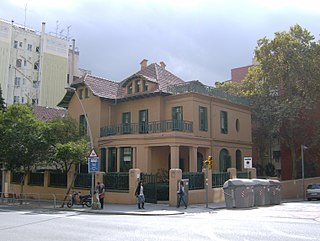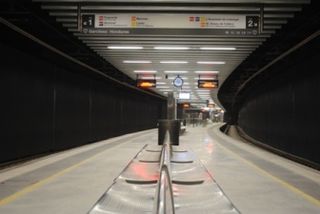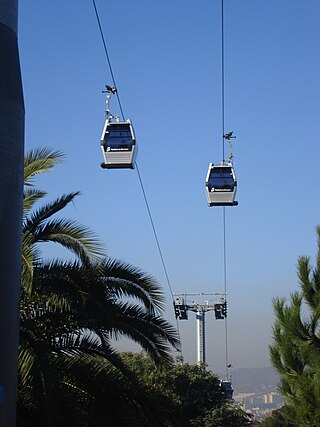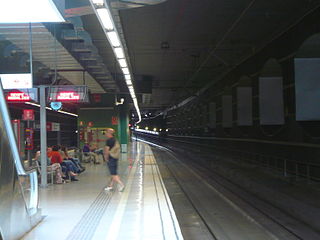
The Barcelona Metro is a network of rapid transit electrified railway lines that run mostly underground in central Barcelona and into the city's suburbs. It is part of the larger public transport system of Barcelona, the capital of Catalonia, Spain, with unified fares under the Autoritat del Transport Metropolità (ATM) scheme. As of 2014, the network is operated by two separate companies: Transports Metropolitans de Barcelona (TMB) and Ferrocarrils de la Generalitat de Catalunya (FGC). It is made up of 12 lines, combining the lines owned by the two companies. Two lines, L9 and L10, are being built at present, with both lines having different sections of each opened between 2009 and 2018. They are due to be fully completed in 2026. Three lines on the network have opened as automatic train operation/driverless vehicle systems since 2009: Line 11 being converted to driverless first, and then Lines 9 and 10, opening up driverless.

Trambesòs is a tram–light rail system in the Spanish autonomous community of Catalonia that links the Barcelona district of Sant Martí with Badalona and Sant Adrià de Besòs. Its name comes from the union of the words "tram", an abbreviation of the Catalan word for "tram" (tramvia), and "Besòs", the name of an area in the north of the Barcelonès region dominated by the Besòs River.

The Montjuïc Funicular is a funicular railway in the city of Barcelona, in Catalonia, Spain. The railway mainly runs through a tunnel and connects the Barcelona Metro's Paral·lel station with the hill of Montjuïc and the various sporting facilities and other attractions there.

The Metropolitan Transport Authority is a public consortium intended to coordinate the operation and project the expansion of the public transport system in the Barcelona metropolitan area. It is made up of the Government of Catalonia and local administrations. It has been known as ATM Àrea de Barcelona since 2003 to differentiate it from the other existing Catalan public transport authorities in the Girona, Camp de Tarragona and Lleida areas, which are also identified as ATM. As of January 2015, the ATM-managed public transport system comprises 50 different operating companies and serves 346 municipalities, accounting for a population of over 5.7 million.

La Sagrera-Meridiana, simply known as La Sagrera, is an interchange complex underneath Avinguda Meridiana, in the Barcelona district of Sant Andreu, in Catalonia, Spain. It consists of a Rodalies de Catalunya station and three Barcelona Metro stations. The Rodalies de Catalunya station is located in the Meridiana Tunnel on the Lleida to Barcelona via Manresa railway, between Sant Andreu Arenal and Arc de Triomf, and is operated by Renfe Operadora. It is served by Barcelona commuter rail service lines R3 and R4, as well as regional rail line R12. The Barcelona Metro stations are on lines 1 (L1) and 5 (L5), as well as the northern section of line 9/10, and are operated by Transports Metropolitans de Barcelona (TMB). On the L1, the station is between Navas and Fabra i Puig, on the L5 between Camp de l'Arpa and Congrés, and on the L9/L10 between Plaça Maragall (future) and Sagrera - TAV. The station is also projected to become the terminus of the L4 once the extension from La Pau opens. A number of interurban bus services stop near the station.
Transports Metropolitans de Barcelona (TMB) is the main public transit operator in Barcelona. A combination of two formerly-separate companies, Ferrocarril Metropolità de Barcelona, SA. and Transports de Barcelona, SA., it runs most of the metro and local bus lines in Barcelona and the metropolitan area.

Avinguda Carrilet, also known as L'Hospitalet Avinguda Carrilet, is an interchange complex underneath Avinguda Carrilet in the L'Hospitalet de Llobregat municipality, to the south-west of Barcelona, in Catalonia, Spain. It consists of a railway station on the Llobregat–Anoia Line and a Barcelona Metro line 1 (L1) station. The Llobregat–Anoia Line station is served by Barcelona Metro line 8 (L8), Baix Llobregat Metro lines S33, S4 and S8, and commuter rail lines R5, R6, R50 and R60. The services on the Llobregat–Anoia Line are operated by Ferrocarrils de la Generalitat de Catalunya (FGC), whilst the L1 is operated by Transports Metropolitans de Barcelona (TMB).
Torre del Baró is a Rodalies de Catalunya station in the Nou Barris district of Barcelona in Catalonia, Spain. It was opened in the 1970s and, since 2003, interconnected with the Barcelona Metro station Torre Baró-Vallbona. It is served by Barcelona commuter rail lines R3, R4 and R7 as well as regional line R12.

Airport T2 is both a Rodalies de Catalunya commuter rail station and a Barcelona Metro station serving terminal complex T2 of Barcelona–El Prat Airport. They are located adjacent to the airport's terminal T2B, in the municipality of El Prat de Llobregat, to the southwest of Barcelona, in Catalonia, Spain. The Rodalies de Catalunya station is the southern terminus of the current rail link coming from El Prat de Llobregat railway station. It is operated by Renfe Operadora and is served by Barcelona commuter rail service line R2 Nord. The metro station is on the airport branch of Barcelona Metro line 9 (L9) and is operated by Transports Metropolitans de Barcelona (TMB).

Rail transport in Catalonia operates on three rail gauges and services are operated by a variety of public operators:
Public transport in Barcelona is operated by several companies, most of which are part of the Autoritat del Transport Metropolità, a transport authority managing services in the Barcelonès and the rest of the metropolitan area of Barcelona. This article is a summary with transport facilities and services strictly within the municipality of Barcelona, and contains links to more specific articles.

Public transport in Santa Coloma de Gramenet is an important part of the Metropolitan Area of Barcelona transportation network. Santa Coloma is a densely populated suburb of the city of Barcelona which fulfills both the role of dormitory town and one of the biggest settlements in the capital's urban area, at around 120,000 inhabitants, and is straddled by Barcelona's Nou Barris and Sant Andreu districts, Badalona, Sant Adrià de Besòs and Montcada i Reixac. The town still relies mostly on bus lines for transportation, but essential improvement arrived in late 2009 with the partial construction of Barcelona Metro line L9. In the future, Generalitat de Catalunya will construct a new line of Tram.

Public transport in Montcada i Reixac is a part of the transportation network in the Metropolitan Area of Barcelona. The town is located in a geographically strategic position, immediately to the north of Barcelona's Nou Barris district and surrounded by the hills of Collserola and the adjacent towns of Vallès, and contains a few train stations which articulate the rail transport in the urban region.

Public transport in Castelldefels belongs to the broader Metropolitan Area of Barcelona transportation network, organised around the entity Autoritat del Transport Metropolità (ATM). Castelldefels is both a dormitory town, with many commuters driving everyday into Barcelona, and an important locality in itself.

Public transport in Sabadell is provided by several services and companies. The city of Sabadell is one of the biggest in Catalonia, and located in the densely urbanised comarca of Vallès Occidental, making up a conurbation with localities such as Terrassa or Rubí. It is also part of the broader Metropolitan Area of Barcelona, and located on fare zone 2 of the city's transportation authority Autoritat del Transport Metropolità (ATM).

The Montjuïc Cable Car is a gondola lift in Barcelona, Catalonia, Spain. The cable car runs from a lower terminus adjacent to the Montjuïc Park upper station of the Montjuïc funicular, and climbs higher up the Montjuïc hill to a terminal near the Montjuïc Castle on the summit of the hill. At its midpoint, the line executes a 90 degree turn and the cabins pass through Mirador station, although only down-bound cabins stop at this point.

Historically, the city of Barcelona, in the Spanish autonomous community of Catalonia, had a large tramway network. The city's first tram line opened in 1872, but almost all of these historic lines had closed by 1971, being replaced by buses and by the expanding Barcelona Metro. The one remaining line, the Tramvia Blau, was retained as tourist attraction, using historic rolling stock. However at the beginning of the 21st century, two new tram systems, the Trambaix and Trambesòs, opened in the suburbs of the city.

Airport T1 is a Barcelona Metro station that serves terminal T1 of Barcelona–El Prat Airport, in the municipality of El Prat de Llobregat, to the southwest of Barcelona. It is the southern terminus of the airport branch of Barcelona Metro line 9 (L9) and is operated by Transports Metropolitans de Barcelona (TMB).

El Prat de Llobregat or El Prat Estació is both a Rodalies de Catalunya and a Barcelona Metro station serving the suburb of El Prat de Llobregat, to the south-west of Barcelona, in Catalonia, Spain. It is on the conventional Madrid–Barcelona railway and is served by all trains on Barcelona commuter rail service lines R2 and R2 Nord, as well as some R2 Sud trains. Some trains on regional line R15 also call at the station. The metro station is on the airport branch of Barcelona Metro line 9 (L9) and is operated by Transports Metropolitans de Barcelona (TMB).

















